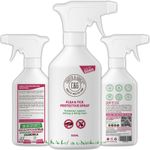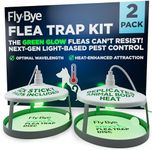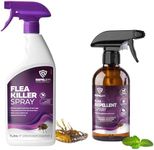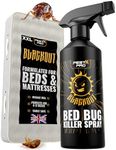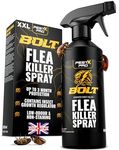Buying Guide for the Best Flea Sprays
Choosing the right flea spray is crucial for effectively managing and preventing flea infestations in your home or on your pets. Flea sprays can vary widely in terms of their active ingredients, application methods, and effectiveness. It's important to consider the specific needs of your household and pets, such as the severity of the infestation, the size of the area to be treated, and any sensitivities or allergies. Understanding the key specifications of flea sprays will help you make an informed decision that ensures the safety and comfort of your pets and family while effectively controlling fleas.Active IngredientsActive ingredients in flea sprays are the chemicals responsible for killing or repelling fleas. This spec is important because it determines the effectiveness of the spray and its safety for pets and humans. Common active ingredients include pyrethrins, permethrin, and insect growth regulators (IGRs). Pyrethrins are natural insecticides derived from chrysanthemum flowers, while permethrin is a synthetic version. IGRs prevent flea eggs and larvae from developing into adults. When choosing, consider any allergies or sensitivities your pets or family members may have. For severe infestations, a combination of adulticides and IGRs may be more effective.
Application MethodThe application method refers to how the flea spray is applied, which can affect its ease of use and coverage. Common methods include aerosol sprays, pump sprays, and foggers. Aerosol sprays are convenient for quick application and can cover large areas, while pump sprays offer more control and are often used for targeted treatment. Foggers release a mist that can penetrate hard-to-reach areas but require vacating the premises during use. Choose an application method that suits your needs, considering the size of the area to be treated and the level of infestation.
Coverage AreaCoverage area indicates how much space a flea spray can effectively treat. This is important to ensure you have enough product to cover the infested areas without needing multiple purchases. Coverage is usually measured in square feet or meters. For small infestations or localized areas, a spray with a smaller coverage area may suffice. For larger homes or severe infestations, look for sprays that offer extensive coverage. Assess the size of the area you need to treat and choose a product that matches or exceeds this requirement.
Safety for Pets and HumansSafety for pets and humans is a critical consideration when choosing a flea spray, as some ingredients can be toxic if ingested or inhaled. This spec is important to prevent adverse reactions in pets and family members. Look for sprays labeled as safe for use around pets and children, and always follow the manufacturer's instructions. If you have sensitive pets or young children, opt for products with natural ingredients or those specifically designed for safety. Consider any known allergies or sensitivities in your household when selecting a product.
Residual EffectResidual effect refers to how long a flea spray continues to kill or repel fleas after application. This is important for ongoing protection and reducing the frequency of reapplication. Some sprays offer immediate results but have a short residual effect, while others provide long-lasting protection. If you prefer less frequent applications, choose a spray with a longer residual effect. Consider the level of infestation and your ability to reapply the product when deciding on the desired residual effect.








